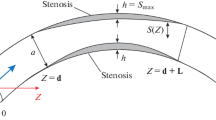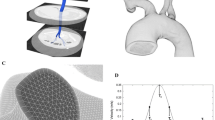Abstract
The infrarenal abdominal aorta is particularly prone to atherosclerotic plaque formation while the thoracic aorta is relatively resistant. Localized differences in hemodynamic conditions, including differences in velocity profiles, wall shear stress, and recirculation zones have been implicated in the differential localization of disease in the infrarenal aorta. A comprehensive computational framework was developed, utilizing a stabilized, time accurate, finite element method, to solve the equations governing blood flow in a model of a normal human abdominal aorta under simulated rest, pulsatile, flow conditions. Flow patterns and wall shear stress were computed. A recirculation zone was observed to form along the posterior wall of the infrarenal aorta. Low time-averaged wall shear stress and high shear stress temporal oscillations, as measured by an oscillatory shear index, were present in this location, along the posterior wall opposite the superior mesenteric artery and along the anterior wall between the superior and inferior mesenteric arteries. These regions were noted to coincide with a high probability-of-occurrence of sudanophilic lesions as reported by Cornhill et al. (Monogr. Atheroscler. 15:13--19, 1990). This numerical investigation provides detailed quantitative data on hemodynamic conditions in the abdominal aorta heretofore lacking in the study of the localization of atherosclerotic disease. © 1998 Biomedical Engineering Society.
PAC98: 8745Hw, 0270Dh, 8710+e
Similar content being viewed by others
REFERENCES
Bogren, H. G., and M. H. Buonocore. Blood flow measurements in the aorta and major arteries with MR velocity mapping. J. Magn. Reson. Imaging4:119-130, 1994.
Brooks, A. N., and T. J. R. Hughes. Streamline upwind Petrov-Galerkin formulation for convection dominated flows with particular emphasis on the incompressible Navier-Stokes equations. Comput. Methods Appl. Mech. Eng.32:199-259, 1981.
Caro, C. G., D. J. Doorly, M. Tarnawski, K. T. Scott, Q. Long, and C. L. Dumoulin. Non-planar curvature and branching of arteries and non-planar type flow. Proc. R. Soc. London, Ser. B452:185-197, 1996.
Cornhill, J. F., E. E. Herderick, and H. C. Stary. Topography of human aortic sudanophilic lesions. Monogr. Atheroscler.15:13-19, 1990
Duncan, D. D., C. B. Bargeron, S. E. Borchardt, O. J. Deters, S. A. Gearhart, F. F. Mark, and M. H. Friedman. The effect of compliance on wall shear in casts of a human aortic bifurcation. J. Biomech. Eng.112:183-188, 1990.
Glagov, S., D. A. Rowley, and R. I. Kohut. Atherosclerosis of human aorta and its coronary and renal arteries. Arch. Pathol.72:82-95, 1961.
Friedman, M. H., G. M. Hutchins, and C. B. Bargeron. Correlation between intimal thickness and fluid shear in human arteries. Atherosclerosis (Berlin)39:425-436, 1981.
He, X., and D. N. Ku. Pulsatile flow in the human left coronary artery bifurcation: Average conditions. J. Biomech. Eng.118:74-82, 1996.
Holenstein, R., and D. N. Ku. Reverse flow in the major infrarenal vessels: A capacitive phenomenon. Biorheology25:835-842, 1988.
Hughes, T. J. R., W. K. Liu, and T. K. Zimmermann. Lagrangian-Eulerian finite element formulation for incompressible viscous flows. Comput. Methods Appl. Mech. Eng.29:329-349, 1981.
Hughes, T. J. R., L. P. Franca, and M. Balestra. A new finite element method for computational fluid dynamics: V. Circumventing the Babuska-Brezzi condition: A stable Petrov- Galerkin formulation of the Stokes problem accommodating equal order interpolations. Comput. Methods Appl. Mech. Eng.59:85-99, 1986.
Hughes, T. J. R., L. P. Franca, and G. M. Hulbert. A new finite element method for computational fluid dynamics: VIII. The Galerkin/least squares method for advective-diffusive equations. Comput. Methods Appl. Mech. Eng.73:173-189, 1989.
Johan, Z., T. J. R. Hughes, and F. Shakib. A globally convergent matrix-free algorithm for implicit time-marching schemes arising in finite element analysis in fluids. Comput. Methods Appl. Mech. Eng.87:281-304, 1991.
Karypis, G., and V. Kumar. A fast and high quality multilevel scheme for partitioning irregular graphs. SIAM J. Sci. Comput. (to appear).
Ku, D. N., D. P. Giddens, C. K. Zarins, and S. Glagov. Pulsatile flow and atherosclerosis in the human carotid bifurcation. Positive correlation between plaque location and low oscillating shear stress. Arteriosclerosis (Dallas)5:293-302, 1985.
Ku, D. N., S. Glagov, J. E. Moore, and C. K. Zarins. Flow patterns in the abdominal aorta under simulated postprandial and exercise conditions: an experimental study. J. Vasc. Surg.9:309-316, 1989.
Kunov, M. J., D. A. Steinman, and C. R. Ethier. Particle volumetric residence time calculations in arterial geometries. J. Biomech. Eng.118:158-164, 1996.
Lei, M., C. Kleinstreuer, and G. A. Truskey. Numerical investigations and prediction of atherogenic sites in branching arteries. J. Biomech. Eng.117:350-357, 1995.
Lei, M., J. P. Archie, and C. Kleinstreuer. Computational design of a bypass graft that minimizes wall shear stress gradients in the region of the distal anastomosis. J. Vasc. Surg.25:637-646, 1997.
Loth, F. Velocity and Wall Shear Stress Measurements inside a Vascular Graft Model under Steady and Pulsatile Flow Conditions. Atlanta, GA: Georgia Institute of Technology, PhD Dissertation, 1993.
Maier, S. E., D. Meier, P. Boesiger, U. T. Moser, and A. Vieli. Human abdominal aorta: Comparative measurements of blood flow with MR imaging and multigated Doppler US. Radiology171:487-492, 1989.
Moore, J. E., D. N. Ku, C. K. Zarins, and S. Glagov. Pulsatile flow visualization in the abdominal aorta under differing physiologic conditions: Implications for increased susceptibility to atherosclerosis. J. Biomech. Eng.114:391-397, 1992.
Moore, J. E., and D. N. Ku. Pulsatile velocity measurements in a model of the human abdominal aorta under resting conditions. J. Biomech. Eng.116:337-346, 1994.
Moore, J. E., and D. N. Ku. Pulsatile velocity measurements in a model of the human abdominal aorta under simulated exercise and postprandial conditions. J. Biomech. Eng.116:107-111, 1994.
Moore, J. E., S. E. Maier, D. N. Ku, and P. Boesiger. Hemodynamics in the abdominal aorta: A comparison of in vitroand in vivomeasurements. J. Appl. Physiol.76:1520- 1527, 1994.
Moore, J. E., C. Xu, S. Glagov, C. K. Zarins, and D. N. Ku. Fluid wall shear stress measurements in a model of the human abdominal aorta: Oscillatory behavior and relationship to atherosclerosis. Atherosclerosis (Berlin)110:225-240, 1994.
Mostbeck, G. H., M. C. Dulce, G. R. Caputo, E. Proctor, and C. B. Higgins. Flow pattern analysis in the abdominal aorta with velocity-encoded cine MR imaging. J. Magn. Reson. Imaging3:617-623, 1993.
Pedersen, E. M., H. W. Sung, A. C. Burlson, and A. P. Yoganathan. Two-dimensional velocity measurements in a pulsatile flow model of the normal abdominal aorta simulating different hemodynamic conditions. J. Biomech.26:1237- 1247, 1993.
Pelc, N. J., F. G. Sommer, K. C. P. Li, T. J. Brosnan, R. J. Herfkens, and D. R. Enzmann. Quantitative magnetic resonance flow imaging. Magn. Reson. Q.10:125-147, 1994.
Perktold, K., M. Resch, and R. Peter. Three-dimensional numerical analysis of pulsatile flow and wall shear stress in the carotid artery bifurcation. J. Biomech.24:409-420, 1991.
Perktold, K., R. O. Peter, M. Resch, and G. Langs. Pulsatile non-Newtonian flow in three-dimensional carotid bifurcation models: A numerical study of flow phenomena under different bifurcation angles. J. Biomed. Eng.13:507-515, 1991.
Perktold, K., and G. Rappitsch. Computer simulation of local blood flow and vessel mechanics in a compliant carotid artery bifurcation model. J. Biomech.28:845-856, 1995.
Rappitsch, G., and K. Perktold. Pulsatile albumin transport in large arteries: A numerical simulation study. J. Biomech. Eng.118:511-518, 1996.
Roberts, J. C., C. Moses, and R. H. Wilkins. Autopsy studies in atherosclerosis: I. Distribution and severity of atherosclerosis in patients dying without morphologic evidence of atherosclerotic catastrophe. Circulation20:511-519, 1959.
Saad, Y., and M. H. Shultz. GMRES: A generalized minimal residual algorithm for solving nonsymmetric linear systems. SIAM (Soc. Ind. Appl. Math.) J. Sci. Stat. Comput.7:856- 869, 1986.
Shephard, M. S., and M. K. Georges. Automatic threedimensional mesh generation by the finite octree technique. Int. J. Numer. Methods Eng.32:709-749, 1991.
Steinman, D. A., and C. R. Ethier. The effect of wall distensibility on flow in a two-dimensional end-to-side anastomosis. J. Biomech. Eng.116:294-301, 1994.
Taylor, C. A., B. I. Tropea, T. J. R. Hughes, and C. K. Zarins. Effect of graded exercise on aortic wall shear stress. Surg. ForumXLVI:331-334, 1995.
Taylor, C. A., T. J. R. Hughes, and C. K. Zarins. Computational investigations in vascular disease. Comput. Phys.10:224-232, 1996.
Taylor, C. A., T. J. R. Hughes, and C. K. Zarins. Finite element modeling of blood flow in arteries. Comput. Methods Appl. Mech. Eng.158:155-196, 1998.
Womersley, J. R., Method for the calculation of velocity, rate of flow, and viscous drag in arteries when the pressure gradient is known. J. Physiol. (London)127:553-63, 1955.
Zarins, C. K., D. P. Giddens, B. K. Bharadvaj, V. S. Sottiurai, R. F. Mabon, and S. Glagov. Carotid bifurcation atherosclerosis: Quantitative correlation of plaque localization with flow velocity profiles and wall shear stress. Circ. Res.53:502-514, 1983.
SHAPES™ Reference Manual, XOX, Inc., 1994.
Adaptive Modeling Language™ Theory Manual, Technosoft, Inc., 1995.
Spectrum™ Theory Manual, Centric Engineering Systems, Inc., 1994.
Spectrum™ Visualizer Reference Manual, Centric Engineering Systems, Inc., 1994.
Author information
Authors and Affiliations
Rights and permissions
About this article
Cite this article
Taylor, C.A., Hughes, T.J.R. & Zarins, C.K. Finite Element Modeling of Three-Dimensional Pulsatile Flow in the Abdominal Aorta: Relevance to Atherosclerosis. Annals of Biomedical Engineering 26, 975–987 (1998). https://doi.org/10.1114/1.140
Issue Date:
DOI: https://doi.org/10.1114/1.140




